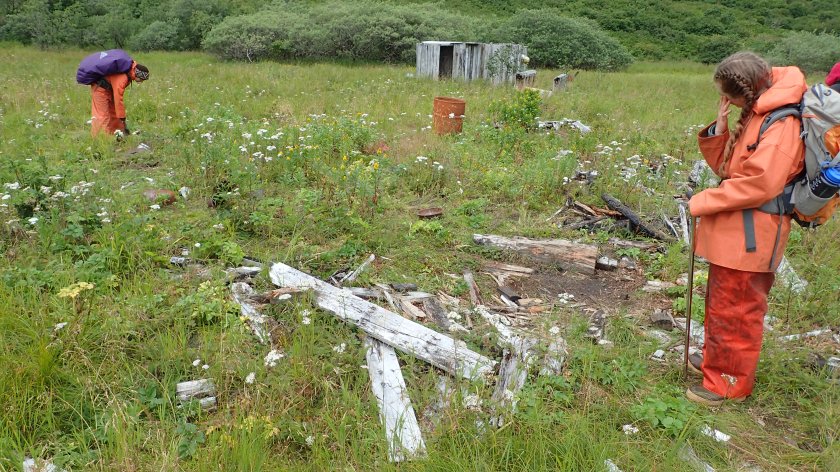On our final day of fieldwork, the team headed west from Old Harbor to Three Saints Bay, which is one bay over from Barling Bay. Three Saints Bay is perhaps infamous in the history of Kodiak as the place where Grigorii Shelikhov built the first permanent Russian settlement in Alaska after orchestrating a brutal massacre of Sugpiaq/Alutiiq people at Refuge Rock (known in the Native language as Awa’uq) in 1784. Russian construction in Three Saints consisted of a main fort (or krepost) and a separate settlement or work camp for Sugpiaq/Alutiiq hostages taken after the massacre. The krepost served as the administrative center of Russia’s Alaskan ventures until it was damaged following earthquakes and the administrative center moved to St. Paul Harbor (modern day Kodiak city) in 1792. What remained was the Sugpiaq/Alutiiq work camp or artel, which continued to be used for at least a couple more decades. It was this site that our team was looking for during our survey of Three Saints Bay.

Since we did not know the exact location of the site, we had to investigate a large swath of the shoreline, watching for eroding artifacts and house pits or other anomalous depressions or ridges as we walked. The first evidence of human occupation we found were the remains of a cabin, which had collapsed and likely been burned no more than a decade before. It was really cool to see an archaeological site in the making with this cabin, as you could still easily discern the structure and numerous artifacts on the surface. I wonder what the cabin site would look like in another 50 years? 100 years?

From the cabin, we continued up the coast, crossing a wide stream into a forested area, where we found a few depressions that looked like small house pits. It would be anomalous for Sugpiaq/Alutiiq people to build houses in such a low, wet, forested area, so we surmised that these Sugpiaq/Alutiiq houses were not placed here by choice. (Later research at the Alutiiq Museum suggests that these houses were part of an American period settlement associated with a cannery.) Nevertheless, the site did not match the description of the one we were looking for, so we continued searching and, as we were heading back to the boat, found a large midden deposit eroding onto the beach. The midden contained preserved shell and bone, in addition to a couple slate artifacts. We had found the artel site!

Closer examination of the eroding midden face and the surface above it suggest that the site has been disturbed by both bear and human digging. We know that a team of University of Wisconsin archaeologists did some testing at the site in early 1960s, but there were more pits in the site than they reported digging. Despite the disturbance and lack of clear house pits, the midden is rich and extends for at least 30 meters along the shoreline – making this a potential site for future sampling or excavation. The site is part of an important story of the early (often violent and cruel) interactions between Sugpiat/Alutiit and Russian fur traders and is also the beginning of the community of Old Harbor, which was the name given to this artel site following the move of the administrative center to St. Paul Harbor.

The question remaining about the site is whether or not we would be able to make sense of any artifacts we may find here, given the disturbed nature of the site (similar to considerations that we need to make about the Lighthouse site). Hollis and Ben are currently thinking through the next steps for the project, including future excavations, as they assemble an official report on the 2018 survey.

One thought on “The Three Saints Bay Artel”